Tugboat
A tugboat or tug is a type of vessel that maneuvers other vessels by pushing or pulling them either by direct contact or by means of a tow line. Tugs typically move vessels that either are restricted in their ability to maneuver on their own, such as ships in a crowded harbor or a narrow canal,[1] or those that cannot move by themselves, such as barges, disabled ships, log rafts, or oil platforms. Tugboats are powerful for their size and strongly built, and some are ocean-going. Some tugboats serve as icebreakers or salvage boats. Early tugboats had steam engines, but today most have diesel engines. Many tugboats have firefighting monitors, allowing them to assist in firefighting, especially in harbors.
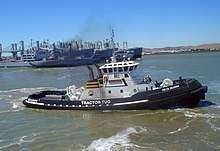
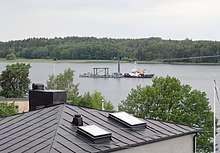
Types
Seagoing
.jpg)
Seagoing tugs (deep-sea tugs or ocean tugboats) fall into four basic categories:
- The standard seagoing tug with model bow that tows by way of a wire cable or on a rope hawser. These are known in the industry as "rope boats" or "wire boats."
- The "notch tug" which can be secured in a notch at the stern of a specially designed barge, effectively making a combination ship. This configuration is dangerous to use with a barge which is "in ballast" (no cargo) or in a head- or following sea. Therefore, "notch tugs" are usually built with a towing winch. With this configuration, the barge being pushed might approach the size of a small ship, with the interaction of the water flow allowing a higher speed with a minimal increase in power required or fuel consumption.
- The "integral unit", or "integrated tug and barge" (ITB), comprises specially designed vessels that lock together in such a rigid and strong method as to be certified as such by authorities (classification societies) such as the American Bureau of Shipping, Lloyd's Register of Shipping, Indian Register of Shipping, Det Norske Veritas or several others. These units stay combined under virtually any sea conditions and the tugs usually have poor sea-keeping designs for navigation without their barges attached. Vessels in this category are legally considered to be ships rather than tugboats and barges must be staffed accordingly. These vessels must show navigation lights compliant with those required of ships rather than those required of tugboats and vessels under tow.
- "Articulated tug and barge" (ATB) units also utilize mechanical means to connect to their barges. The tug slips into a notch in the stern and is attached by a hinged connection. ATBs generally utilize Intercon and Bludworth connecting systems. ATBs are generally staffed as a large tugboat, with between seven and nine crew members. The typical American ATB displays navigational lights of a towing vessel pushing ahead, as described in the 1972 ColRegs.
Harbour
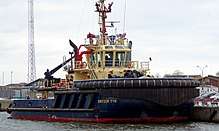
Compared to seagoing tugboats, harbour tugboats are generally smaller and their width-to-length ratio is often higher, due to the need for a lower draught. In smaller harbours these are often also termed lunch bucket boats, because they are only manned when needed and only at a minimum (captain and deckhand), thus the crew will bring their own lunch with them.[2] The number of tugboats in a harbour varies with the harbour infrastructure and the types of tugboats. Things to take into consideration include ships with/without bow thrusters and forces like wind, current and waves and types of ship (e.g. in some countries there is a requirement for certain numbers and sizes of tugboats for port operations with gas tankers).[3]
River
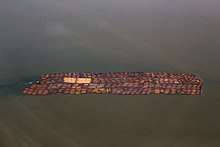
River tugs are also referred to as towboats or pushboats. Their hull designs would make open ocean operation dangerous. River tugs usually do not have any significant hawser or winch. Their hulls feature a flat front or bow to line up with the rectangular stern of the barge, often with large pushing knees.
Propulsion
The first tug boat, the Charlotte Dundas, was built by William Symington in 1801. She had a steam engine and paddle wheels and was used on rivers in Scotland. Paddle tugs proliferated thereafter and were a common sight for a century. See Eppleton Hall In the 1870s schooner hulls were converted to screw tugs. Compound steam engines and scotch boilers provided 300 Indicated Horse Power. Steam tugs were put to use in every harbour of the world towing and ship berthing.
Tugboat diesel engines typically produce 500 to 2,500 kW (~ 680 to 3,400 hp), but larger boats (used in deep waters) can have power ratings up to 20,000 kW (~ 27,200 hp). Tugboats usually have an extreme power:tonnage-ratio; normal cargo and passenger ships have a P:T-ratio (in kW:GRT) of 0.35 to 1.20, whereas large tugs typically are 2.20 to 4.50 and small harbour-tugs 4.0 to 9.5.[4] The engines are often the same as those used in railroad locomotives, but typically drive the propeller mechanically instead of converting the engine output to power electric motors, as is common for diesel-electric locomotives. For safety, tugboats' engines often feature two of each critical part for redundancy.[5]
A tugboat is typically rated by its engine's power output and its overall bollard pull. The largest commercial harbour tugboats in the 2000s–2010s, used for towing container ships or similar, had around 60 to 65 short tons-force (530–580 kN) of bollard pull, which is described as 15 short tons-force (130 kN) above "normal" tugboats.[6][7]

Tugboats are highly maneuverable, and various propulsion systems have been developed to increase maneuverability and increase safety. The earliest tugs were fitted with paddle wheels, but these were soon replaced by propeller-driven tugs. Kort nozzles (see below) have been added to increase thrust per kW/hp. This was followed by the nozzle-rudder, which omitted the need for a conventional rudder. The cycloidal propeller (see below) was developed prior to World War II and was occasionally used in tugs because of its maneuverability. After World War II it was also linked to safety due to the development of the Voith Water Tractor, a tugboat configuration which could not be pulled over by its tow. In the late 1950s, the Z-drive or (azimuth thruster) was developed. Although sometimes referred to as the Aquamaster or Schottel system, many brands exist: Steerprop, Wärtsilä, Berg Propulsion, etc. These propulsion systems are used on tugboats designed for tasks such as ship docking and marine construction. Conventional propeller/rudder configurations are more efficient for port-to-port towing.
Kort nozzle
The Kort nozzle is a sturdy cylindrical structure around a special propeller having minimum clearance between the propeller blades and the inner wall of the Kort nozzle. The thrust-to-power ratio is enhanced because the water approaches the propeller in a linear configuration and exits the nozzle the same way. The Kort nozzle is named after its inventor, but many brands exist.
Cycloidal propeller
The cycloidal propeller is a circular plate mounted on the underside of the hull, rotating around a vertical axis with a circular array of vertical blades (in the shape of hydrofoils) that protrude out of the bottom of the ship. Each blade can rotate itself around a vertical axis. The internal mechanism changes the angle of attack of the blades in sync with the rotation of the plate, so that each blade can provide thrust in any direction, similar to the collective pitch control and cyclic in a helicopter.
Tugboat fenders

Tugboat fenders are made of high-abrasion-resistance rubber with good resilience properties. They are very popular with small port craft owners and tug owners. These fenders are compression moulded in high-pressure thermic-fluid-heated moulds and have excellent seawater resistance. Tugboat fenders are also called beards or bow pudding. In the past they were made of rope for padding to protect the bow.
Other design innovations
A recent Dutch innovation is the Carousel Tug, winner of the Maritime Innovation Award at the Dutch Maritime Innovation Awards Gala in 2006.[8] The Carousel Tug adds a pair of interlocking rings to the body of the tug, the inner ring attached to the boat, with the outer ring attached to the towed ship by winch or towing hook. Since the towing point rotates freely, the tug is very difficult to capsize.[9]
Operation
Starting a drag
 The head tractor gets a heaving line from the container ship
The head tractor gets a heaving line from the container ship The bow line with messenger is taken from the container ship
The bow line with messenger is taken from the container ship The stern line is passed from the rear tractor
The stern line is passed from the rear tractor A crew member of the container ship takes the stern line and fastens it
A crew member of the container ship takes the stern line and fastens it The stern tow line is fixed to the container ship Manila Express, the drag is started
The stern tow line is fixed to the container ship Manila Express, the drag is started
Other activities
Races
Vintage rugboat races have been held annually in Olympia, Washington since 1974 during the Olympia Harbor Days Maritime Festival. Tugboat races are held annually on Elliott Bay in Seattle,[10] on the Hudson River at the New York Tugboat Race,[11] the Detroit River,[12] and the Great Tugboat Race and Parade on the St. Mary's River.[13]
Ballet
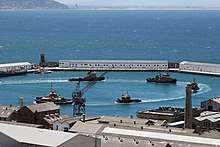
Since 1980, an annual tugboat ballet has been held in Hamburg harbour on the occasion of the festival commemorating the anniversary of the establishment of a port in Hamburg. On a weekend in May, eight tugboats perform choreographed movements for about an hour to the tunes of waltz and other sorts of dance music.[14]
Roundups
The Tugboat Roundup is a gathering of tugboats and other vessels in celebration of maritime industry. The Waterford Tugboat Roundup It is held in the late summer at the confluence of the Hudson and Mohawk Rivers in Waterford, New York. The tugs featured are river tugs and other tugs re-purposed to serve on the New York State Canal System.[15]
In popular culture
Tugboat Annie was the subject of a series of Saturday Evening Post magazine stories featuring the female captain of the tugboat Narcissus in Puget Sound, later featured in the films Tugboat Annie (1933), Tugboat Annie Sails Again (1940) and Captain Tugboat Annie (1945). The Canadian television series The Adventures of Tugboat Annie was filmed in 1957.
Film and television
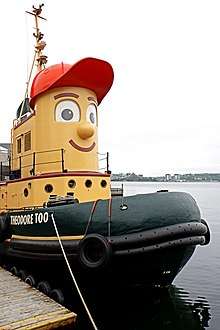
To date, there have been four children's shows revolving around anthropomorphic tugboats.
- In the late 1980s, 13 episodes were made of TUGS, a series depicting the life of tugboats in the 1920s.
- An American adaptation using edited footage from Tugs followed: Salty's Lighthouse.
- In the 1975's Soviet short animation musical film В порту/ In the sea port a tugboat sang a song: "Through a harbour area"
- One of the creators of Tugs went on to direct Theodore Tugboat.
- Animated preschool series Toot the Tiny Tugboat started broadcasting on Channel 5 Milkshake! in 2014 and on Cartoonito in 2015, with a Welsh-language version airing on S4C Cyw.
"Tugger" is a tugboat in the animated series South Park. He appears in the episode "The New Terrance and Phillip Movie Trailer" as a sidekick for Russell Crowe in a fictitious television series entitled Fightin' Round The World with Russell Crowe. Tugger follows Crowe as he engages various people in physical conflicts, providing emotional support and comic relief. At one point Tugger even attempts to commit suicide, upon being forced to hear Russell Crowe's new musical composition.
Literature
(Alphabetical by author)
- The children's book Scuffy the Tugboat, written by Gertrude Crampton and illustrated by Tibor Gergely and first published in 1946 as part of the Little Golden Books series, follows the adventures of a young toy tugboat who seeks a life beyond the confines of a tub inside his owner's toy store.
- The Dutch writer Jan de Hartog wrote numerous nautical novels, first in Dutch, then in English.
- The novel Hollands Glorie, written prior to World War II, was made into a Dutch miniseries in 1978 and concerned the dangers faced by the crews of Dutch salvage tugs.[16][17]
- The novella Stella, concerning the dangers faced by the captains of rescue tugs in the English Channel during World War II, was made into a film entitled The Key in 1958.[18]
- The novel The Captain (1967), about the captain of a rescue tug during a Murmansk Convoy, sold over a million copies.[19]
- Its 1986 sequel, The Commodore, features the narrator captaining a fleet of tugs in peace-time.
- Little Toot (1939), written and illustrated by Hardie Gramatky, is a children's story of an anthropomorphic tugboat child, who wants to help tow ships in a harbour near Hoboken. He's rejected by the tugboat community and dejectedly drifts out to sea, where he accidentally discovers a shipwrecked liner and a chance to prove his worth. This story was animated as part of the Disney movie Melody Time.
- Farley Mowat's book The Grey Seas Under tells the tale of a legendary North Atlantic salvage tug, the Foundation Franklin. He later wrote The Serpent's Coil, which also deals with salvage tugs in the North Atlantic.
Images
 Swedish harbour tug Svitzer Freja in tug-operation (3,600 kW / 453 gross register tons (GRT))
Swedish harbour tug Svitzer Freja in tug-operation (3,600 kW / 453 gross register tons (GRT)) Dutch river tugboat "Mascotte II"
Dutch river tugboat "Mascotte II" German harbour-tug and DDR quick-freighter Karl Marx at Rostock harbour
German harbour-tug and DDR quick-freighter Karl Marx at Rostock harbour- The tugboat Woona in Sydney Harbour, Australia
 Danish Svitzer Tyr in Ystad harbour 2018.
Danish Svitzer Tyr in Ystad harbour 2018. Danish Baltsund in Ystad harbour 2019.
Danish Baltsund in Ystad harbour 2019. Tugs towing an Oil Tanker (VLCC).
Tugs towing an Oil Tanker (VLCC).
See also
- Admiralty tug
- American Waterways Operators
- Azipod
- Charlotte Dundas
- E3 Tug Project
- Fish tug
- Maritime pilot
- PS Comet
- Pusher (boat)
- Switcher, rail analog
- Tugboats in New York City
- Type V ship
Notes
- "How Pygmy Tugboats Dock a Giant Liner." Popular Science Monthly, March 1930, p. 22-23.
- Thorndike, Virginia L. (2004). On Tugboats: Stories of Work and Life Aboard. Down East Books. pp. 14–16. ISBN 0-89272-565-6.
- Thoresen, Carl A. (2003). Port Designer's Handbook: Recommendations and guidelines. Thomas Telford Books. p. 116. ISBN 0-7277-3228-5.
- Poulsen, B. Lund; et al. (1971). Teknisk Leksikon [The Technological Encyclopaedia] (in Danish). 2. København: A/S Forlaget for Faglitteratur København/Oslo. pp. 163–190. ISBN 87 573 0023 2.
- Bilinski, Marcie B.: "The Workhorse of the Waterways" Massachusetts Office of Coastal Zone Management, Coastlines 2007
- "Rotor Tug "RT Zoe"". Marineline.com. 13 September 2006. Retrieved 19 August 2013.
- "Western Marine to build tugboat, vessel for Ctg port". The Independent. 4 June 2012. Retrieved 19 August 2013.
- novatugnews. "Novatug.nl news". Novatug. Archived from the original on 2007-09-08. Retrieved 2008-01-18.
- novatugprod. "Novatug.nl product information". Novatug. Archived from the original on 2008-01-19. Retrieved 2008-01-18.
- "Port of Seattle". Portseattle.org. Retrieved 2012-02-18.
- "In search of the toughest tug," by Laurel Graeber, New York Times, August 29, 2008.
- "tugrace.com". tugrace.com. 2013-06-22. Retrieved 2014-03-23.
- The Great Tugboat Race
- "Schlepperballett: Kaiserwalzer der Kolosse – SPIEGEL ONLINE – Nachrichten – SPIEGEL TV". Spiegel.de. Retrieved 2012-02-18.
- https://www.tugboatroundup.com/
- "Hollands glorie". IMDb. Retrieved 2008-01-20.
- Mel Gussow (September 24, 2002). "Jan de Hartog, 88, Author of His Own Life". The New York Times. Retrieved 2008-01-20.
- "The Key". IMDb. Retrieved 2008-01-20.
- "Hartog, Jan De [1914 – 2002]". New York State Library. Retrieved 2008-01-20.
References
- Jane's Ocean Technology 1979–80 / Jane's Yearbooks, 1979 – ISBN 0-531-03902-1.
- On Tugboats: Stories of Work and Life Aboard / Virginia Thorndike – Down East Books, 2004.
- Under Tow: A Canadian History of Tugs and Towing / Donal Baird – Vanwell Publishing, 277 p., 2003 – ISBN 1-55125-076-4
- Pacific Tugboats: / Gordon Newell – Superior Publishing Company 1957, Seattle Washington.
- Primer of Towing / George H. Reid – Cornell Maritime Press, 1992.
Further reading
- Lehman, Charles F. (2009). A riverman's lexicon : in Lehman's terms. Florissant, Mo.: J.R. Simpson & Associates. ISBN 978-0-9841503-0-4. Nautical terminology specific to towboating on inland waterways.
External links
| Wikimedia Commons has media related to Tugboat. |
- A site for boatmen.
- At the Port of Felixstowe
- Beacon Finland Ltd JAK®-ATB Coupling System
- Compagnie Maritime Chambon
- "Docking The World's Great Liners" Popular Mechanics, May 1930, article on docking large ships in the first half of the 20th century using tugboats
- Intercon ATB Couplers
- NYC's Annual Tugboat Races
- Tugboat Enthusiasts Society
- University of Wisconsin–La Crosse Historic Steamboat Photographs
- Voith-Schneider Propeller
- Waterford Tugboat Roundup